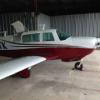Search the Community
Showing results for tags 'aileron'.
-
MSers: I inadvertently deleted the earlier thread. ALL the previous information was fantastic! I'll try to pickup where we left off … with what I thought I was going to delete (not the thread Between the B and C, rudder travel was changed from 18 +/-1 to 23 +1/-0 because the amount of (cross control) rudder travel required for crosswind landings was considered to be not enough. Aileron travel was not changed. This larger rudder travel still exists on new airplanes (so all the later short, mid and long bodies). The irony in this is that a rudder-aileron interconnect was added mid C (not at the beginning of the C models). It was stated that the interconnect was added for better lateral-directional stability. Although this would be true, it also stated that it was only effective for the higher rudder deflections. Using experience, it is possible that the rudder forces are light (and lighter more as travel is increased) and the rudder could hang when out that far (and cross controlled). Just a thought, but the interconnect would bring it back. In addition, the interconnect increases the forces required for crosswind landings. Let's get this party started … again. -Ron
- 36 replies
-
- interconnect
- aileron
-
(and 2 more)
Tagged with:
-
The aileron push-pull control tube is a great example to look at the tradeoffs in materials, tolerances, costs, weights, certification, manufacturing, etc. and how each of these is related to each other. I probably won't think of everything but here's a conversation starter. 1) weight - aluminum, composite then steel, but I think that they would all be fairly close. 2) cost - steel, aluminum then composite. 3) manufacturing - steel/aluminum then composite 4) Stiffness - composite, steel then aluminum The problem is they all relate to each other and all have very strong positives and negatives. Here's some random thoughts. Steel produces the smallest diameter. Flexibility (buckling) is both good and bad. For metallic tubes, it allows less binding (and resulting lower control force); for composite (very stiff), alignment has to be perfect or it won't move. To back this, the 3 hinges on the aileron are rarely in perfect alignment, but when installed they move easily because the aluminum aileron flexes slightly to allow for it. A composite aileron does not (an M10 learning experience). Certification would be a large expense for composite as the material and processes would need to be qualified and tested. BUT (and this is where OEMs today are missing it) if one could find an off-the-shelf, commercially-produced tube that would work, end pieces could be designed to mate with the tube and the current attach points. Each tube assembly would need to be strength tested, but that is A LOT less work than certifying an original design. The match has been lit. Go!
-
On my 77 M20J I have noticed it takes some good left aileron to fly straight in flight. With auto pilot on the ball is to the left and attitude indicator showing a slight bank. When turning off the auto pilot hands off she wants to bank right. I looked at the ailerons today and the right one is higher then the left one by about 1/2" when comparing it to the wing. What do you guy's think? Thanks
-
1963 M20C at the paint shop...plane gets painted, time to balance ailerons and rudder...all are too heavy on trailing edge. 1963 MM has no info on adding or subtracting weight. Email to Mooney Tech support engineers explaining issue...after a few conversations Mooney Engineers say " use detailed instructions from the M20J MM, the methods apply to all models". Problem solved...Almost...now The paint shop wants to know max weight for ailerons and rudder...(for paint thickness) M20J MM states no max Weight, just paint and balance. Anyone ever hear of a max weight for the ailerons or rudder? Thanks
-
Hey gang, I am a new mooney M20j 205 owner. I took it in to upgrade the avionics and to get the gross weight increase done. When I went to pick it up I tested the controls. When the plane nose gear is straight the yoke will spring back to neutral when turned to the right but not spring back when turned to the left. If you turn the nose wheel to the right the controls are equal both ways. Is this normal? The shop did pull the rudder to balance it for the gross weight increase. They also resealed the tanks. Any suggestions to what would cause this or is it normal?
-
When my plane is on the ground, I can align one aileron trailing edge with the flap and the other one also lines up. I understand due to the nature of the push rod linkages there is a small amount of "play" between the two ailerons, but it is very small. Hold one in place and the other can move maybe 1/4". In flight, the ailerons look way out of alignment, as much as an inch, usually the right will be high with the left aligned with the flap. I am at a loss as to how this occurs. Any thoughts?




